| Author |
Message |
Hal Siegel
Industry Professional

Location: Austin, Texas Joined: 30 Aug 2003
Posts: 113
|
|
   |
 |
Chuck Russell

|
 Posted: Mon 30 May, 2011 9:12 am Post subject: Posted: Mon 30 May, 2011 9:12 am Post subject: |
 |
|

GDFB poleaxe, MRL Bill, Lutel Bec de Corbin
|
|
    |
 |
|
Bob Burgess
Location: Wiltshire UK Joined: 30 May 2011
Posts: 21
|
 Posted: Sun 05 Jun, 2011 8:51 am Post subject: 45 degree spike Posted: Sun 05 Jun, 2011 8:51 am Post subject: 45 degree spike |
 |
|
I notice on the bec de corbin in the last post the spike is turned through 45 degreees, a feature also seen on Roman axes (construction tools) from Newstead Fort in Scotland, boarding pikes and modern fireman's axes.... I hadn't given it much thought, but it would seem that it would be easier to extract from armour or wood than one not turned diagonally...
Has anyone experimented with this, or do members of the forum have any thoughts on the subject????
My query started with a tool or weapon (still trying to determine exactly what it is) discovered during an archeological dig in Quebec Canada - http://outils-anciens.xooit.fr/t2783-Aider-l-archeologie.htm
 Attachment: 23.86 KB Attachment: 23.86 KB
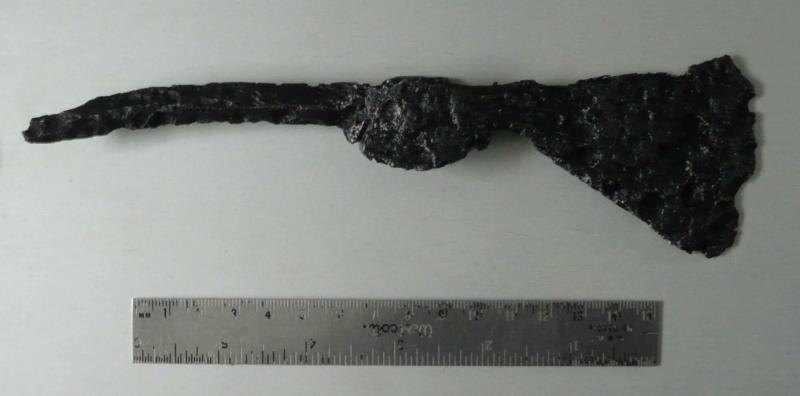
After cleaning and conservation
Edge tool collector and historian, with a special interest in the billhook...
|
|
  |
 |
|
M. Livermore
|
 Posted: Sun 05 Jun, 2011 2:00 pm Post subject: Posted: Sun 05 Jun, 2011 2:00 pm Post subject: |
 |
|
|
My experimentation with axes shaped similarly to the one you have shown suggests that you are correct. The motion of the arm when striking and recovering from a strike tends to cause the held implement to describe a circle or portion thereof. Turned spikes are much easier to extract for that reason, at least in my experience.
|
|
  |
 |
Sa'ar Nudel

|
 Posted: Mon 06 Jun, 2011 2:01 am Post subject: Re: 45 degree spike Posted: Mon 06 Jun, 2011 2:01 am Post subject: Re: 45 degree spike |
 |
|
This is both tool & weapon. Although similar to the Spanish 17th c. issue boarding axe this is probably a spike tomahawk. Similar one can bee seen in Hartzler & Knowles, Indian Tomahawks & Frontiersmen Belt Axes, p.42 fig.13.
Here are several of my staff weapons, all are antique and munition grade, not to say peasant. For comparison, the blade length of the voulge (longest arm on top) is 60cm (appr. 2').
 Attachment: 222.09 KB Attachment: 222.09 KB
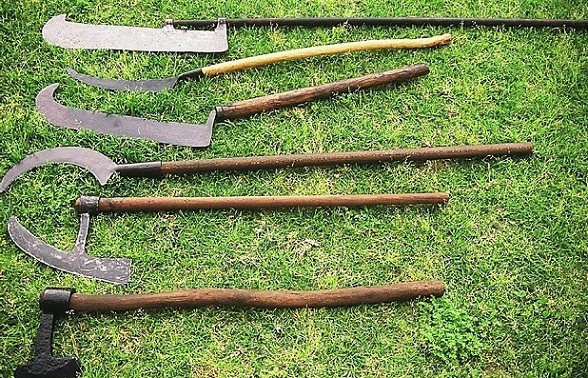
Curator of Beit Ussishkin, regional nature & history museum, Upper Galilee.
|
|
   |
 |
Ed Toton

|
 Posted: Tue 07 Jun, 2011 10:51 am Post subject: Posted: Tue 07 Jun, 2011 10:51 am Post subject: |
 |
|
Unfortunately I don't really have any good pictures of my polearms.
But here's my custom A&A glaive (next to the A&A Henry V):
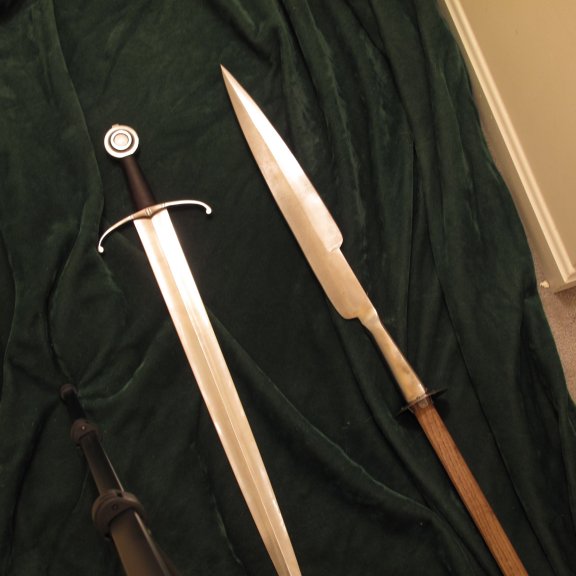
A&A Hungarian Axe:

And a really ancient picture of some of my other long pointies:
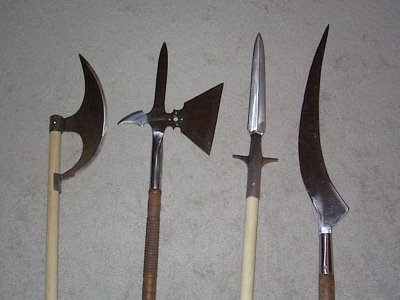
(left to right: CAS-Iberia Sparth Axe, a cheap display-only halberd, CAS Iberia lugged spear, very cheap sickle-spear I picked up at some renfaire somewhere)
-Ed T. Toton III
ed.toton.org | ModernChivalry.org
My armor photos on facebook
|
|
   |
 |
Felix R.

|
 Posted: Tue 02 Aug, 2011 2:15 am Post subject: Posted: Tue 02 Aug, 2011 2:15 am Post subject: |
 |
|
Today I finally got my Poleaxe made by Manfred Pany. The idea was to make it late 14th early 15th cent. There seem to be no surviving pieces from that time. But we included sources from artwork and features from the later surviving examples. The idea was to mae it more simple and less decorated than gothic pieces. And have it sqare instead of diamond shaped (standing on the edge). Here are some sources, pictures will be added during the day.
 Attachment: 65.78 KB Attachment: 65.78 KB

 Attachment: 72.69 KB Attachment: 72.69 KB
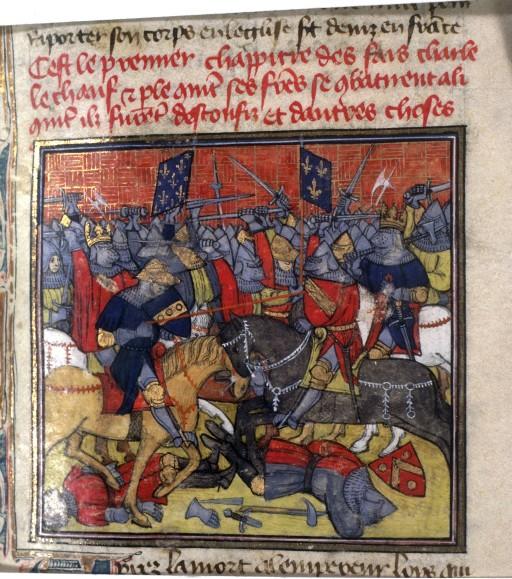
 Attachment: 93.35 KB Attachment: 93.35 KB
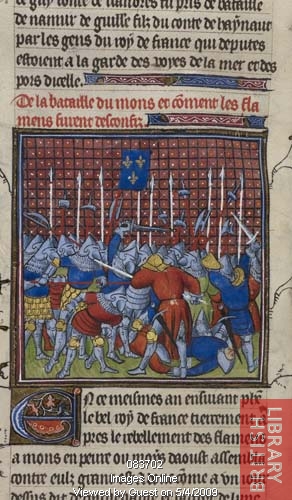
 Attachment: 41.22 KB Attachment: 41.22 KB
[ Download ]
|
|
  |
 |
Felix R.

|
 Posted: Tue 02 Aug, 2011 3:57 am Post subject: Posted: Tue 02 Aug, 2011 3:57 am Post subject: |
 |
|
Here are the pictures, the post is app. 1.85m in height.
There is also a buttspike, which is not so sharp, but more harassing than a square end.
 Attachment: 164.62 KB Attachment: 164.62 KB
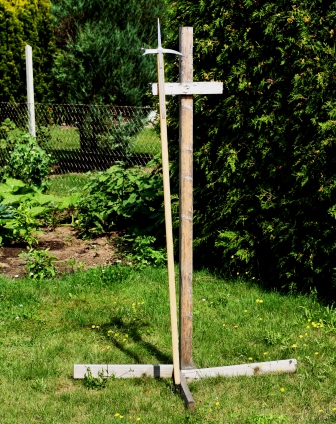
 Attachment: 86.67 KB Attachment: 86.67 KB
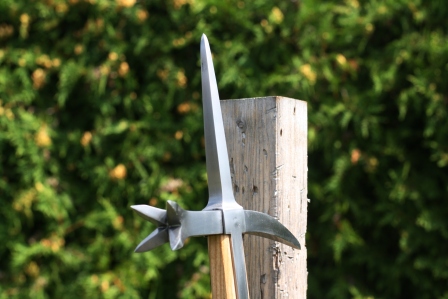
 Attachment: 80.4 KB Attachment: 80.4 KB
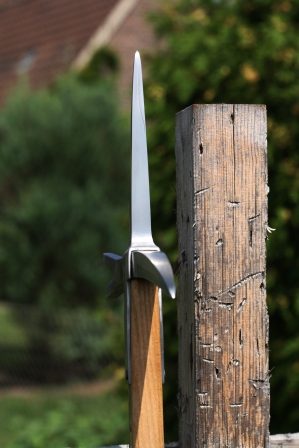
 Attachment: 72.82 KB Attachment: 72.82 KB

 Attachment: 93.16 KB Attachment: 93.16 KB
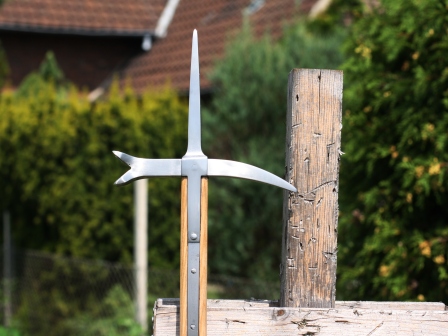
|
|
  |
 |
Bartek Strojek

|
 Posted: Tue 02 Aug, 2011 6:40 am Post subject: Posted: Tue 02 Aug, 2011 6:40 am Post subject: |
 |
|
Very nice piece!
Lack of surviving originals is certainly disheartening, so far we're doomed to do educated guesses.
But I like this interpretation a lot.
|
|
  |
 |
|
Ralph Grinly
|
 Posted: Tue 02 Aug, 2011 1:44 pm Post subject: Posted: Tue 02 Aug, 2011 1:44 pm Post subject: |
 |
|
|
That looks very nice . Have you given it a work-out yet ? I'm curious about the rear 'beak". If used against armour, and that penetrated the metal - I'm thinking that the leverage on a shaft that long would snap the shaft before the beak could be levered out of the hole it made on penetration ??. To me..it seems you'd have to shift your grip much closer to the head to pull it out ?
|
|
  |
 |
Felix R.

|
 Posted: Wed 03 Aug, 2011 4:17 am Post subject: Posted: Wed 03 Aug, 2011 4:17 am Post subject: |
 |
|
|
I don´t think that the beak is meant to pierce armour, so no need to lever it out of the punched hole. On the other hand the whole piece is slightly longer than my personal height, which goes well with the dimensions shown in fencing manuscripts. You won´t hold it at end tho swing it around anyway.
|
|
  |
 |
|
Bob Burgess
Location: Wiltshire UK Joined: 30 May 2011
Posts: 21
|
 Posted: Sun 07 Aug, 2011 12:55 am Post subject: Weapons or tools?? Posted: Sun 07 Aug, 2011 12:55 am Post subject: Weapons or tools?? |
 |
|
Hi
Whilst the objects in Sa'ar Nudel's picture would make formidable weapons, I would say that their principal function is peaceful, and that they are all agricultural or vineyard tools. Further all appear to be French in origin, and I would guess the makers marks will show them to be 19th century, or even possible 20th century in origin... The style of these tools has remained unchanged through the centuries, and they were most probably the precursors of many type of pole arm. As mentioned on several other posts on this forum, not all armies were of trained soldiers, many peasants were pressed into service and had to take whatever weapoin they could find, or that they could make from their everyday tools c.f. the blade of a humble billhook having a spike or hook attached, fitted to a long pole and thus becomong a bill...
Numbering from the top: 1 and 3 are coupe-marcs, used in the cider and vine making regions of France to cut up the marc, or residue after the juice has been pressed out of the fruit. Each region of France has its own individual shape, and these are from the north west of France, around Normandy. 2 and 5 are probably coupe- près, used to open up drainage channels in grass lands, especially in regions that have (had??) water meadows - they may also be coupe- marcs, or possibly on poorer farms an old and worn coupe marc would become the coupe-prè.
4 is a croissant, in UK Englsih a slasher or staff hook, i.e. a hedging billhook on a long handle...
6 is a bit of a mystery, but my best guess would be an old no 5, with most of the blade worn or ground away....
For further reading I would recommend the books of Daniel Boucard, published in France by Jean Cyrille Godefroy: http://jean-cyrille-godefroy.izibookstore.com...%20Boucard
Or look at the French Old Tools website: http://outils-anciens.xooit.fr/f6-Identification-d-outils.htm
e.g.:
http://outils-anciens.xooit.fr/t2510-Outil-ou...htm?q=arme
http://outils-anciens.xooit.fr/t2664-Coupe-ma...coupe+marc
http://outils-anciens.xooit.fr/t2509-pour-le-...coupe+marc
Edge tool collector and historian, with a special interest in the billhook...
|
|
  |
 |
|
Julian Reynolds
Location: United Kingdom Joined: 30 Mar 2008
Posts: 271
|
 Posted: Sun 07 Aug, 2011 2:24 am Post subject: Posted: Sun 07 Aug, 2011 2:24 am Post subject: |
 |
|
Bob,
That's a great French website/forum you linked to - it warrants lots more investigation!
It does throw up the question of how many of these old tools end up in the States being sold as 'medieval weapons' by unscrupulous vendors to unknowing customers.......
Julian
|
|
  |
 |
|
Sam Gordon Campbell
Location: Australia. Joined: 16 Nov 2008
Posts: 678
|
 Posted: Sun 07 Aug, 2011 4:36 am Post subject: Posted: Sun 07 Aug, 2011 4:36 am Post subject: |
 |
|
So, in order to get tools like that, I'd have to open up a vineyard?
Wine and revolts; I like the sound of that!
Member of Australia's Stoccata School of Defence since 2008.
Host of Crash Course HEMA.
Founder of The Van Dieman's Land Stage Gladiators.
|
|
  |
 |
Sa'ar Nudel

|
 Posted: Sun 07 Aug, 2011 4:43 am Post subject: Posted: Sun 07 Aug, 2011 4:43 am Post subject: |
 |
|
| Julian Reynolds wrote: | Bob,
It does throw up the question of how many of these old tools end up in the States being sold as 'medieval weapons' by unscrupulous vendors to unknowing customers.......
Julian |
So true. I had several "affairs" with sellers on ebay, some of them highly respectable (or so they seem), trying to explain such things. The common mistake is to post a decorated goosewing side-axe as an "executioner's axe". Bob of course is correct with his identification, I just argue the age of #1 which is to my best knowledge very old - hammer marks all over and forge welded joints with loss of material and deep patina. Although industrialized tools were introduced to the market from about 1860, rural France still employed blacksmiths well into the 20th century. #5 is known also as turff axe, but with a blade over 1' long weighing 4-1/2 pounds on a 4' haft it makes a great weapon for hacking, stabbing and grappling. It is very well made with obvious forge-welded seams. #6 is a cut-down version.
I have an additional bi-socketed coup-marc (not on the photo) with a blade cut from a sheet steel, nicely marked, and the two sockets are cast steel and riveted to the blade.
Boucard's books are great, I have them and also a few axes from his collection.
Curator of Beit Ussishkin, regional nature & history museum, Upper Galilee.
|
|
   |
 |
|
Bob Burgess
Location: Wiltshire UK Joined: 30 May 2011
Posts: 21
|
 Posted: Sun 07 Aug, 2011 2:52 pm Post subject: Posted: Sun 07 Aug, 2011 2:52 pm Post subject: |
 |
|
One of the problems is that these tools are virtually unknown in the English speaking world. Secondly they are virtually unchanged in shape since the Middle Ages or even earlier. Thirdly French edge tool makers (taillandiers) continued forge welding of tools in small rural forges well into the 20th century. The situation was similar in other European countries. A 1960's survey of the Balkans undertaken by a French university discovered medieval tools and technology in everday use..
Les outils dans les Balkans du Moyen Age à nos jours. Coffret 2 volumes - Giustina Ostuni - 1986 - EHESS
(EHESS = L'école de haute études en sciences sociales - Paris - Department of Ethonolgie et Anthropologie)
Bernard Solon, Maison Alexis in Orléans (France), although well into his 70's, and in semi-retirement, still forge welds the blades of his vineyard hoes, incorporating a thin layer of harder, wear resistant high carbon steel into the medium carbon steel blade. As the softer steel wears away it exposes the harder core, making them self sharpening... His grandfather, who founded the forge, taught him this method, so it was still being practised after WW11....
I have the names of over 4000 french taillandiers who worked from about 1830 to 1940, and these are only the ones who had bought an entry into the year books - I have many more tools by unrecorded makers...
With regard to sellers offering tools from Europe in the USA as weapons, I have seen many instances - it is not only bearded axes (goosewing) that are sold as executioners' axes, but also the axe shaped coupe-marc from the Burgundy region of France. I also saw a late 19th early 20th century German billhook that I had bid on on ebay.de in 2008 being sold in the USA 2009 as an 18th century Pensylvania Dutch made tool - in the intervening year it had also acquired a Certificate of Authenticity. The seller had the decency to admit he had been fooled when I showed him the ebay images I copied in 2008 - it was identical right down to the scratch marks on the handle.... It just had the maker's initials on the blade, and a half dozen touch marks....
Museums are equally bad in getting their facts wrong, see the link 'Outil ou Arme' in my previous post... One of my aims is to try and correct these errors before they become 'gospel' because some 'expert' has written a book citing an error. For my part, if I am wrong I am happy to admit my mistake... please feel free to shoot me down...
 Attachment: 66.09 KB Attachment: 66.09 KB
A bill hook from Sicily - 20th century - no maker's name, but blade covered in touch marks (found in the USA) [ Download ]
 Attachment: 109.49 KB Attachment: 109.49 KB
Close up of touch mark [ Download ]
Edge tool collector and historian, with a special interest in the billhook...
|
|
  |
 |
Corey Skriletz

Location: United States Joined: 27 May 2011
Posts: 118
|
 Posted: Sun 15 Jan, 2012 12:58 am Post subject: Re: 45 degree spike Posted: Sun 15 Jan, 2012 12:58 am Post subject: Re: 45 degree spike |
 |
|
| Quote: | | (left to right: CAS-Iberia Sparth Axe, a cheap display-only halberd, CAS Iberia lugged spear, very cheap sickle-spear I picked up at some renfaire somewhere) |
Ed, that's a great collection. I especially like that sickle-spear. Do you know when they started using that weapon in Western Europe?
|
|
  |
 |
|
Bob Burgess
Location: Wiltshire UK Joined: 30 May 2011
Posts: 21
|
 Posted: Sun 15 Jan, 2012 2:19 am Post subject: Posted: Sun 15 Jan, 2012 2:19 am Post subject: |
 |
|
Interesting - what you identify as a weapon (sickle spear) I see as a tool....
The staff hook has been in use throughout Europe for over 2000 years as a hedging tool - basically a billhook on a long handle. This one is very close to some of the regional patterns of croissant found in France, just a little more open... (those from the Jura region to the east and the Landes to the west are very open).
In the wine growing regions of France open blades sickles on both short and long handles were used to remove excess foliage from the grape vines to allow sunlight in to ripen the grapes.
Similar tools were also used as eaves knives, to cut back the underside of overhanging thatch on a roof that could not be reached from the topside of the roof. Those in the east of the UK have a straight blade up to 3ft (900mm) long mounted on a handle about 4 ft (1.2m) long or longer (depending upon the type of roof and the height of the building). In the west of the UK it is more like a straight sickle mounted on a short handle, and used from a ladder.
Edge tool collector and historian, with a special interest in the billhook...
|
|
  |
 |
|
F Hynd
Location: Bristol Joined: 08 Oct 2011
Posts: 24
|
 Posted: Thu 17 May, 2012 3:35 pm Post subject: Posted: Thu 17 May, 2012 3:35 pm Post subject: |
 |
|
My first full polearm after a pair of long spears. hanwei glaive head on a octagonal ash haft for a total length of 6'6.
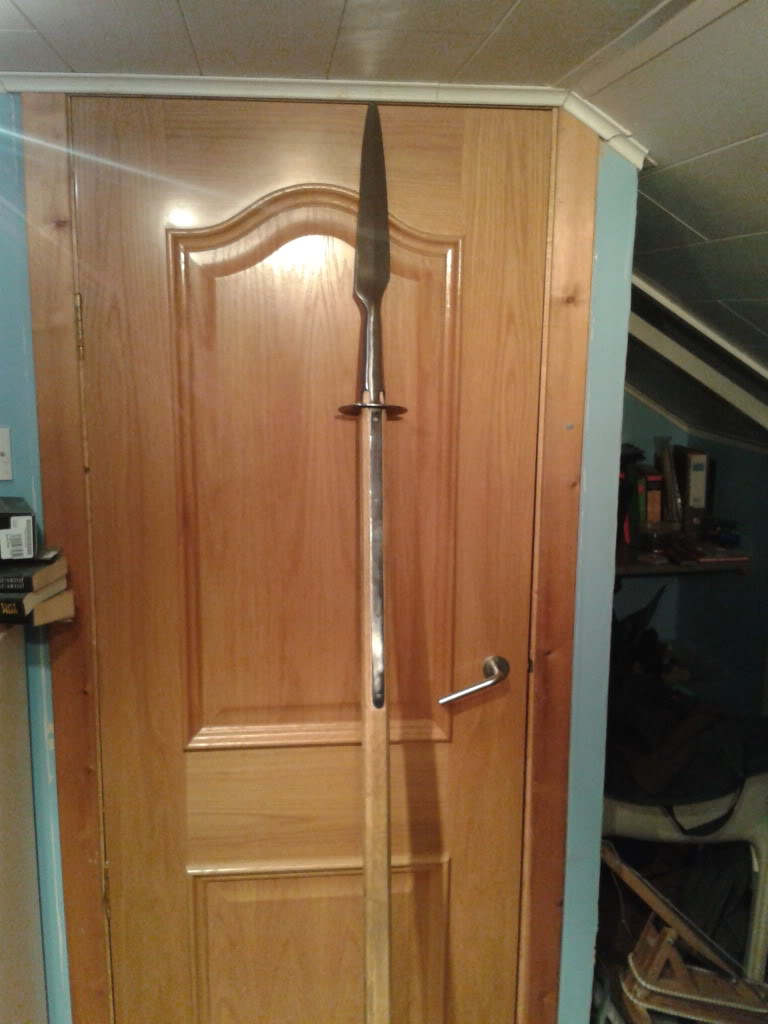
|
|
  |
 |
Ed Toton

|
 Posted: Tue 22 May, 2012 11:56 am Post subject: Re: 45 degree spike Posted: Tue 22 May, 2012 11:56 am Post subject: Re: 45 degree spike |
 |
|
| Corey Skriletz wrote: | | Quote: | | (left to right: CAS-Iberia Sparth Axe, a cheap display-only halberd, CAS Iberia lugged spear, very cheap sickle-spear I picked up at some renfaire somewhere) |
Ed, that's a great collection. I especially like that sickle-spear. Do you know when they started using that weapon in Western Europe? |
As far as I know, as a "war scythe" there are some very recent (19th century) examples, however Fauchards of similar design may have existed as far back as the 11th century.
Here is an newer photo with some of my other pieces in it (including a few from my earlier photos):
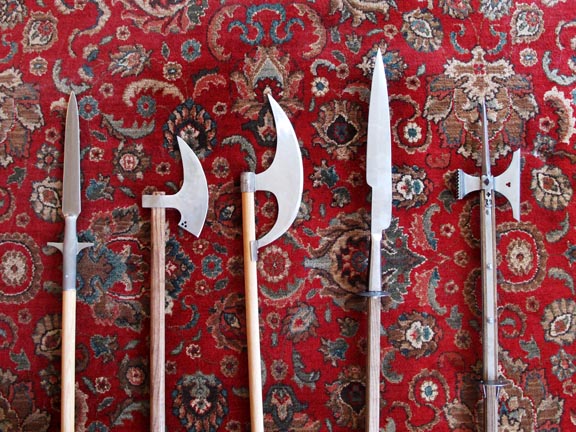
Left to Right: CAS-Iberia lugged spear, A&A Hungarian Axe, CAS-Iberia Sparth Axe, A&A Glaive, A&A Knightly Poleaxe
-Ed T. Toton III
ed.toton.org | ModernChivalry.org
My armor photos on facebook
|
|
   |
 |
|
|

